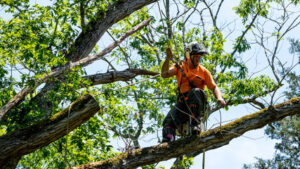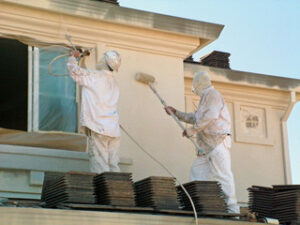Tree Trimming Chula Vista is a crucial part of routine landscape maintenance. When performed correctly, it can boost flower and fruit production, as well as increase the overall health of your trees and shrubs.

A properly conducted trim will reduce branches that interfere with power lines or obstruct views and improve the look of your property. However, improper pruning can damage or even kill your plants.
Tree trimming is a crucial component of horticultural care for your property. Not only can it improve the beauty of your landscape, but it also promotes healthy growth and prevents damage from pests, disease, and other environmental conditions. Understanding how and when to perform these maintenance tasks is vital for ensuring the long-term health of your trees.
Aesthetic pruning is a meticulous practice that takes into account the central form and overall structure of each tree. It aims to achieve a balanced appearance by eliminating branches that are dead or crossing, improving light penetration and air flow, and reducing the risk of storm damage. This technique is best performed during the dormant season, typically in late winter or early spring, as it minimizes stress on the plant and allows it to heal quickly.
The goal of aesthetic pruning is to create a pleasing, natural appearance that complements the surrounding landscape and enhances the property’s value. This is accomplished by removing dead or damaged branches and promoting balanced growth through careful shaping of the crown. Aesthetic pruning techniques can be applied to any type of tree or shrub, but it is especially important for enhancing the beauty of your landscape and preventing damage caused by pests and weather.
While removing dead or damaged branches is an essential part of any trimming project, it is equally important to consider the overall structure and shape of each tree. Overgrown branches can restrict sunlight and prevent proper root development, which will lead to a misshapen canopy and a crowded, unbalanced appearance. Aesthetic pruning focuses on achieving a balanced, attractive look by removing excessive growth, maintaining a clear view, and preserving the shape of the crown.
When performing aesthetic pruning, it is critical to understand the specific needs of each tree. A professional, certified arborist is the ideal partner for assessing your property’s needs and creating a customized plan that will maintain the health of your trees while achieving a desirable aesthetic. Using the correct tools, such as pruning shears and loppers, and working during the appropriate season will ensure that your trees are properly shaped to avoid unnecessary damage.
Health
Tree Trimming is a great way to improve the health and appearance of your trees. It can prevent the spread of disease and infection, which will help to increase the lifespan of your trees. It can also reduce the risk of damage during severe weather events. Branches that hang over or near your home or other structures can pose a safety hazard during storms and high winds. Regular tree trimming can remove these branches and prevent them from falling and damaging your property.
It can also promote new growth, which can help to strengthen your tree and create a more natural shape. Removing dead or dying branches can help to prevent insect infestations and improve air circulation throughout the canopy, which can reduce the chance of fungus infections. It can also eliminate crossing or rubbing branches that can cause damage to other parts of the tree and lead to rot.
A professional tree trimmer can use a variety of techniques to help your trees grow in a healthy and attractive manner. They can trim dead or damaged limbs, thin dense tree canopies, remove suckers and water sprouts, and correct lopsided or misshapen trees. They can also use vista pruning to create a more appealing view of your landscape.
The most common types of cutting are thinning cuts and heading cuts. Thinning cuts remove interior branches and foliage to reduce the amount of weight on the ends of branches, reducing the chance of breakage during storms or windy conditions. It can also improve air circulation in a tree canopy and enhance light penetration to the interior leaves or ground below. Thinning cuts should never remove more than one-quarter of a tree’s overall diameter.
Heading cuts remove a branch at its point of attachment, often to a higher lateral branch. They can be used to control excessive growth, encourage new branch development and correct asymmetrical or uneven crowns. They should be made with caution and only when necessary, as they can have a negative impact on the overall health of the tree.
Safety
Keeping your trees properly trimmed is an effective way to keep them healthy and safe. Proper trimming reduces the risk of damage to your property from strong winds or storms by removing branches that hang over or near buildings, homes, cars, power lines and other structures. It also reduces the risk of insect infestations by limiting the amount of moisture available in the tree canopy, which prevents fungal growth and makes the tree less appealing to insects.
Regular pruning helps to encourage new, vigorous growth by promoting air circulation and sunlight penetration. It also removes dead or damaged branches and promotes overall tree health. In addition, trimming allows you to better manage the shape and structure of your landscape, adds a finished look to your yard, and enhances your property’s curb appeal.
It is important to note that proper pruning requires the assistance of an experienced and certified arborist. These professionals have the knowledge and skills necessary to safely perform the work, and they adhere to industry safety standards. In addition, they understand the nuances of each species of tree and know how to best prune them for aesthetics, safety, and health.
Overgrown trees can cause a variety of problems, including safety hazards, obstruct views, and interfere with structures like power lines. By trimming and pruning trees regularly, you can maintain their health and appearance.
Proper trimming is an important part of a landscaping plan, and it can help to keep your home or business looking its best. Untrimmed trees can make your home or business appear unkempt and uncared for, but by regularly trimming your trees, you can improve your property’s curb appeal and boost its value.
While it may seem tempting to trim your own trees, it is important to realize that this is a dangerous and difficult job. Improper pruning or trimming at the wrong time can cause serious damage to a tree, and it is also extremely hazardous to climb large or tall trees, especially when they are located near power lines. It is best to hire a professional tree trimming company with the proper equipment and expertise to conduct this type of work.
Maintenance
Trees are a major part of the overall appearance of your property. Annual trimming keeps them healthy and prevents overgrowth. The proper timing of trimming and the pruning technique used will have a significant impact on the appearance of your trees.
Trimming removes dead, damaged or infected branches from your trees and promotes healthy growth patterns. It also helps your trees stay strong and safe from damage during storms and high winds. Additionally, trimming helps keep your trees away from power lines and other structures.
During the trimming process, our experts will carefully inspect each individual tree and its health before performing any cuts. This will include examining the trunk and limb structure, as well as determining the overall stability of the tree. Taking all of these factors into consideration, our team will trim your trees to improve their aesthetics, safety and health while keeping them looking beautiful for years to come.
Overgrown branches are not only unsightly, but they can also be a risk to people and vehicles. Regular trimming and pruning helps reduce the potential for damage from wind, storms, or snow. It also reduces the chances of the branches falling and causing damage to property or injury to individuals.
Maintaining the health of your trees and landscape is an investment that will pay dividends for many years to come. A well-maintained yard and healthy trees increase the value of your home or business and provide a pleasant, natural setting for outdoor living and recreation.
Branches that are dead or diseased can be a magnet for pests. When left unattended, they can quickly degrade and lead to the death of a tree or the spread of disease to other parts of the landscape. Regular trimming will eliminate the problem before it becomes a major issue.
Thinning is the most common form of pruning performed on mature trees. It involves removing specific live branches to reduce the overall density of the crown, which in turn increases air circulation and sunlight penetration while reducing stress on selected limbs from wind, snow, gravity and ice.

